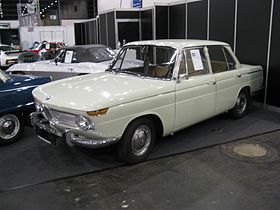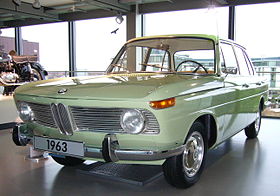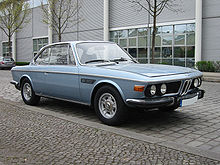BMW New Class
| BMW New Class | |
|---|---|
 BMW 1600 | |
| Overview | |
| Manufacturer | BMW |
| Production | 1962–1977 |
| Assembly | Munich, Germany Jakarta, Indonesia (Gaya Motor) |
| Body and chassis | |
| Body style | 4-door sedan 2-door GT coupe |
| Layout | FR layout |
| Related | BMW 02 Series |
| Powertrain | |
| Engine | 1.5-2.0 L M10 4-cyl |
| Chronology | |
| Successor | BMW 5 Series for sedans BMW E9 for coupes |
The BMW New Class (German: Neue Klasse) was a line of sedans and coupes produced by German automaker BMW between 1962 and 1977. These models ensured BMW's solvency after the company's financial crisis of the 1950s and established the identity of BMW automobiles as sports sedans.
The first New Class vehicle was the 1500, a 4-door compact executive car with the new M10 (at the time called M115) OHC 4-cylinder engine. In 1965, the 2000C and 2000CS luxury coupés were added to the range.
Replacement of the New Class models began with the larger 2000C and 2000CS coupés, which were replaced by the 6-cylinder E9 2800CS in 1969. In 1972, the 4-door sedans were replaced by the larger E12 5 Series.
The New Class coupes introduced the Hofmeister kink, which has been used on most BMW cars since. Another legacy of the New Class is the iconic 02 Series, which are a shortened version of the New Class sedans.
Overview
Background
During the 1950s, the BMW line-up consisted of luxury cars with displacements of two litres or greater, economy cars powered by motorcycle engines, and motorcycles. With their luxury cars becoming increasingly outdated and unprofitable and their motorcycles and economy cars becoming less attractive to an increasingly affluent society, BMW needed a car in the 1.5 to 2 litre class to become competitive. Prototypes powered by a 1.6 L engine based on one bank of the BMW OHV V8 engine were built and evaluated without a convincing result.[1]: 130–131
In 1960, Herbert and Harald Quandt invested heavily in BMW, and gained a controlling interest in the company.[1]: 134 That year, the "Neue Klasse" project was begun. Led overall by Fritz Fiedler, the project had Eberhard Wolff in charge of chassis design, Wilhelm Hofmeister in charge of styling and body engineering, and Alex von Falkenhausen in charge of engine design.[1]: 136 The team was to produce a new car with a new engine, which BMW had done since the 303 in 1933.
The prototype was introduced in September 1961 at the Frankfurt Motor Show as the BMW 1500 four-door saloon,[2]: 62 alongside the BMW 3200 CS, the last BMW with the OHV V8.[1]: 131
The term New Class referred to the 1.5–2–liter class of automobiles from which BMW had been absent since World War II.
Chassis and body
The three-box four-door saloon was in many ways conventional, using a unitary structure and MacPherson strut front suspension which were becoming mainstream by the time of the 1500s introduction.[3] Less conventional was the independent rear suspension, which featured coil springs and semi-trailing wishbones pivoted from a stout cross beam that also supported the differential housing.[3] While BMW was using MacPherson struts for their first time on the New Class, they had used unit body construction on the 700 and semi-trailing arm rear suspension on the 600 and the 700.[1]: 137 [2]: 62 All New Class cars had front disc brakes.
Engines
The M10 overhead camshaft engine used in the New Class was required to displace 1.5 L initially, with the possibility to be expanded to 1.8 L. Von Falkenhausen had earlier designed an engine prototype for possible use in the BMW 700 and used this as a starting point for the M10.[1]: 136 [2]: 62 The engine was canted over at 30 degrees to the right of vertical in order to allow for the low bonnet line, which also contributed to the styling of the car.[3]
Financial results

In the years preceding the New Class's 1962 release, BMW had recorded many operating losses. In 1962, the company broke even, with a turnover of 294 million marks. In 1963, sales increased by 47% to 433 million marks, and BMW was able to pay dividends to its shareholders for the first time in 20 years.[2]: 63
Production figures
| Model | Units[4]: 171-195 |
|---|---|
| 1500 (1962−64) | 23,554 |
| 1600 (1964−66) | 9,728 |
| 1800 (1963−72) | 146,960 |
| 1800 TI/SA (1964−65) | 200 |
| 2000 (1966−72) | 143,464 |
| 2000 C/CS (1965−69) | 13,691 |
New Class Sedans
| BMW New Class sedan | |
|---|---|
 BMW 1500 | |
| Overview | |
| Also called | 1500, 1800, 1800 TI, 1800TI/SA, 1600, 2000, 2000 TI, 2000 tilux, 2000 tii |
| Production | 1500: 1962–1964 1800: 1963–1971 1600: 1964–1966 2000: 1966–1972 |
| Designer | Wilhelm Hofmeister Giovanni Michelotti, consultant[2]: 61 |
| Body and chassis | |
| Class | Mid-size luxury / Executive car (E) |
| Body style | 4-door sedan |
| Powertrain | |
| Engine | M10 4-cyl 1500: 1,499 cc 1800: 1,773 cc (1964–1968), 1,766 cc (1968–1971) 1600: 1573 cc 2000: 1,990 cc |
| Transmission | 4-speed manual 5-speed manual on 1800 TI/SA 3-speed automatic optional on 1800/2000 |
| Dimensions | |
| Wheelbase | 2,550 mm (100 in)[1]: 137 |
| Length | 4,500 mm (180 in) |
| Width | 1,650 mm (65 in) |
| Height | 1,420 mm (56 in) |
| Chronology | |
| Successor | BMW E12 (BMW 5-Series) |
1500

Introduced in September 1961 at the Frankfurt Motor Show, the BMW 1500 entered regular production in October 1962 and was manufactured until December 1964.
The M10 4-cylinder engine used oversquare dimensions of 82 mm (3.2 in) bore and 71 mm (2.8 in) stroke produced 60 kW (80 hp) in the BMW 1500.[5]
Contemporary reports praised the all-round visibility and the commanding driving position while recording that it was necessary to lean forward a little to engage first and third gears due to the long travel distance of the gear lever.[5] The large 40 cm tall luggage compartment was also commended.[5]
The 1500 could accelerate to 100 km/h (62 mph) in approximately 15 seconds.[5] The performance was at the time considered lively in view of the engine size, and although the engine needed to be worked hard in order to achieve rapid progress, it ran smoothly even at speeds above 6,000 rpm.[5] The firm suspension and correspondingly harsh ride surprised those conditioned by the BMW 501 to anticipate a more comfort-oriented suspension setup.[5]
Notable problems that developed with the 1500 included separation of the semi-trailing arm mounts from the body, rear axle failure, and gearbox problems. These were resolved in later versions of the New Class sedan.[2]: 64
The 1500 was replaced in 1964 by the 1600,[1]: 139 but it was still made available in markets where capacities greater than 1500 cc incurred higher tax rates.
1800

Introduced in September 1963, the BMW 1800 was the second member of the New Class family. This model had an M10 engine with a 84 mm (3.3 in) bore and 80 mm (3.1 in) stroke, giving a displacement of 1,773 cc. It produced 67 kW (90 hp) at 5,250 rpm and 130 N⋅m (96 lb⋅ft) at 3,000 rpm.[1]: 140–141 [2]: 64–66
The 1800 TI (Turismo Internazionale) model featured components developed for the 1800 by the tuning company Alpina.[6] The upgrades included dual Solex PHH side-draft carburetors and higher-compression pistons for 82 kW (110 hp) at 5,800 rpm and 136 N⋅m (100 lb⋅ft) at 4,000 rpm.[1]: 141
A homologation special, the 1800 TI/SA, was introduced in 1964.[2]: 64–66 [1]: 141 The TI/SA's engine had dual Weber DCOE-45 carburetors [7] and a 10.5:1 compression ratio. This engine produced 97 kW (130 hp) at 6,100 rpm and 144 N⋅m (106 lb⋅ft) at 5,250 rpm. The TI/SA also had a Getrag five-speed gearbox, stronger anti-roll bars, and larger-diameter brake discs than the TI. 200 examples of the TI/SA were built[2]: 64–66 and were only sold to licensed racing and sports drivers.
An automatic transmission option was introduced in 1966 and in 1967 the 1800 was generally updated along with the 2000. The updates included interior changes (a modernized dashboard design and simpler door panels) as well as styling changes to the front grilles.[citation needed]
In 1968 the 1,773 cc engine used in the 1800 was replaced by an engine with the 89 mm (3.5 in) bore of the 2.0 L engine and the original 71 mm (2.8 in) stroke, which resulted in a displacement of 1,766 cc and a stroke/bore ratio of 0.798:1 (compared with the previous 1800 engine's ratio of 0.952:1).[1]: 144
1600
The 1600, introduced as the replacement to the 1500 in 1964, used the 84 mm (3.3 in) bore of the 1800 with the 1500s 71 mm (2.8 in) stroke, resulting in a displacement of 1,573 cc,[2]: 64 [1]: 141 a power output of 62 kW (83 hp) at 5,500 rpm and 113 N⋅m (83 lb⋅ft) at 3,000 rpm. The 1600 was produced until early 1971.[1]: 141
2000

The engines from the 2000C and 2000CS coupes were used in the 4-door sedan body for the 2000 and 2000TI models. The 2000 sedan, released in 1965, used the 75 kW (101 hp) engine from the 2000 C. The 2000TI sedan, released in 1966, used the 90 kW (121 hp) engine from the 2000 CS with twin Solex PHH side-draft carburetors.[1]: 142–143 [2]: 67
Intended as an upscale version of the 1800, the 2000 featured distinct wide taillights, more exterior trim, and unique rectangular headlights. The American market 2000 sedans could not have the rectangular headlights due to government regulations. A different grille with four individual round headlights, similar to the design that BMW later used in the 2500 sedan, was offered in the US. The 2000TI retained the '1800' taillights and headlights.[citation needed] A more luxurious 2000TI-lux (later "tilux") featured the sporty TI engine with a more high-grade interior and accessories,[1]: 143 including a wood dashboard and optional leather seats.
In a 1967 test, Road & Track felt that the 2000 sedan was "the best performing 2-liter sedan in today's market and the best handling and best riding as well."[citation needed]
In 1969, BMW introduced the 2000tii ('touring international, injected'), BMW's first fuel-injected model, featuring Kugelfischer mechanical fuel injection.[1]: 144 The 2000tii produced 97 kW (130 hp) at 5,800 rpm and 178 N⋅m (131 lb⋅ft) at 4,500 rpm.[2]: 74 1,952 2000tii cars were built of this final New Class sedan model.[1]: 144
Production volumes
Note that not all models are included.
| Model | 1600 | 1800 | 1800 TI | 1800 TI/SA |
|---|---|---|---|---|
| 1963 | 8,346 | |||
| 1964 | 2131 | 25,063 | 8,191 | |
| 1965 | 6,395 | 38,048 | 12,427 | 200 |
| 1966 | 1,202 | 13,393 | 4 | |
| 1967 | 8,893 | 419 | ||
| 1968 | 7,777 | 67 | ||
| 1969 | 11,273 | 1 | ||
| 1970 | 14,367 | |||
| 1971 | 7,654 | |||
| Total | 9,728 | 134,814 | 21,116 | 200 |
Special Models
In 1972 BMW developed its first electric car based on the 1602 model. The BMW 1602 Elektro-Antrieb was first unvieled at the 1972 Olympic Games in Munich, Germany; two examples were used to shuttle VIPs and serve as support cars in various long-distance events like the marathon.[8]
New Class Coupés
| BMW 2000C/CS | |
|---|---|
 | |
| Overview | |
| Manufacturer | BMW |
| Production | 1965-1969 |
| Assembly | by Karmann at Osnabrück |
| Designer | Wilhelm Hofmeister |
| Body and chassis | |
| Class | Grand tourer (S) |
| Body style | 2-door coupé |
| Layout | FR layout |
| Platform | BMW New Class |
| Related | BMW New Class BMW E9 |
| Powertrain | |
| Engine | 2.0 L OHC I4 2000C: single carburettor, 100 hp (75 kW) at 5500 rpm 2000CS: two carburettors, 120 hp (89 kW) at 5500 rpm |
| Transmission | 4 speed manual 3 speed automatic (available on 2000C only) |
| Dimensions | |
| Wheelbase | 2,550 mm (100 in)[9] |
| Length | 4,530 mm (178 in)[9] |
| Width | 1,675 mm (65.9 in)[9] |
| Height | 1,360 mm (54 in)[9] |
| Chronology | |
| Predecessor | BMW 3200 CS |
| Successor | BMW 2800CS |
The BMW New Class coupé range, which comprised the BMW 2000C and BMW 2000CS, was a coupé body style built by Karmann for BMW from the summer of 1965[1]: 141 [2]: 66–67 to 1969. In 1965, BMW ended production of their Bertone-bodied 3200 CS coupé, the last of their line of V8 powered luxury cars from the 1950s. BMW decided to continue with a coachbuilt coupé. Based on the New Class platform, the 2000C and 2000CS introduced the 2.0 L version of the M10 4-cylinder engine and replaced the 3200 CS as BMW's flagship model in 1965.[2]: 66 . The New Class coupes were replaced by the E9 coupés, which were based on a stretched 2000CS chassis and use a 6-cylinder engine.
Technical
The New Class coupé was developed from the New Class sedans to showcase the 2.0 L version of the engine used in the sedans. The new displacement of 1,990 cc (121 cu in) was achieved with the 80 millimetres (3.1 in) stroke of the 1.8 L version combined with a 89 millimetres (3.5 in) bore. The coupé was built for BMW by Karmann in Osnabrück and was available as the 2000C, with a single-carburettor engine delivering 100 horsepower (75 kW) at 5500 revolutions per minute, or as the 2000CS with a twin-carburettor engine delivering 120 hp (89 kW) at 5500 revolutions per minute.[1]: 141 [2]: 66–67 Both versions used a four speed manual transmission as standard, while the 2000C was available with a three speed automatic transmission as an optional extra.[1]: 141 [2]: 66-67
Styling


The New Class coupé was introduced just after the 3200CS coupé was discontinued.[2]: 66–67 The styling was based on the 3200CS and the New Class sedan, but the styling of the front of the car was all-new.[1]: 141 [2]: 66–67 The headlights were behind a glass fairing, and the grill consisted solely of a chromed BMW "double-kidney" at the centre of the front. Apart from chrome accents around the headlights and along the top of the front end, the rest of the front was painted metal, with a row of vertical slots behind the bumper to admit air for cooling and engine induction.[1]: 145 [10] Reactions to the front end styling have been mixed; Norbye describes it as "a blunt, unattractive front end",[1]: 141 Severson agrees, calling the front clip "odd-looking" and stating that the details of the front end "do no favors for the looks",[10] while Noakes disagrees, referring to its "imposing front end" being "tidier than the Bertone body's fussy nose" in comparison to the 3200CS.[2]: 66–67
Reception
Of the 13,691 New Class coupés built between 1965 and the end of production in mid-1969,[1]: 142 9,999 were twin carburettor 2000CS coupés, 3,249 were single carburettor 2000C coupés with automatic transmission, and 443 were 2000C coupés with manual transmission.[1]: 251
Succession

The development of the BMW New Six meant that the New Class coupé would no longer be at the top of the BMW line. The coupe was modified with a longer wheelbase and longer front clip to accommodate the new six-cylinder engine. The front end styling was also modified to resemble that of the "New Six" E3 sedan. This resulted in the BMW E9 platform.[1]: 168
References
- ^ a b c d e f g h i j k l m n o p q r s t u v w x y z aa Norbye, Jan P. (1984). BMW - Bavaria's Driving Machines. Skokie, IL: Publications International. ISBN 0-517-42464-9.
- ^ a b c d e f g h i j k l m n o p q r s Noakes, Andrew (2005). The Ultimate History of BMW. Bath, UK: Parragon Publishing. ISBN 1-4054-5316-8.
- ^ a b c Garnier, Peter, ed. (23 November 1974). "Buying Secondhand: BMW 1800 and 2000". Autocar. Vol. 141 (nbr 4074). pp. 54–56.
- ^ Oswald, Werner (2001). Deutsche Autos 1945-1990, volume 4 (in German). Motorbuch Verlag. ISBN 3-613-02131-5.
- ^ a b c d e f Ostmann, Bernd, ed. (8 January 2003). "Vor 40 Jahren: Bayern Vier". Auto, Motor und Sport. Vol. 2003 Heft 2. p. 162.
- ^ Walker, Steve (April 2014). "1800 TiSA". Roundel. BMW Car Club of America. pp. 82–85. ISSN 0889-3225.
- ^ "1966 BMW 1800". www.conceptcarz.com. Archived from the original on 13 May 2012. Retrieved 23 February 2013.
{{cite web}}: Unknown parameter|deadurl=ignored (|url-status=suggested) (help) - ^ Vijayenthiran, Viknesh (19 March 2015). "1972 BMW 1602e: BMW's First Electric Car Detailed In New Video". Motor Authority. Retrieved 5 May 2016.
- ^ a b c d "1965 BMW 2000 C". www.carfolio.com.
- ^ a b "From Bavaria with Love: The BMW E9 Coupes". www.ateupwithmotor.com.
Further reading
- Crow, James T., ed. (1968). "Two BMWs". Road & Track Road Test Annual. pp. 61–65.
![]() Media related to BMW 2000 CS at Wikimedia Commons
Media related to BMW 2000 CS at Wikimedia Commons
